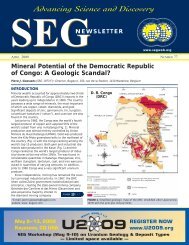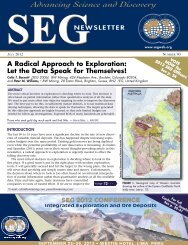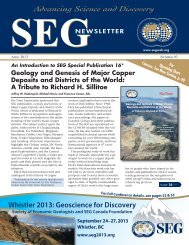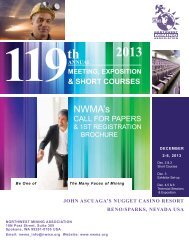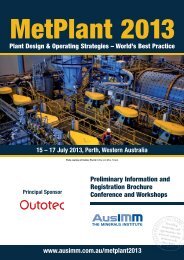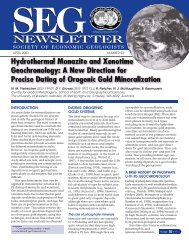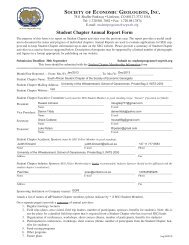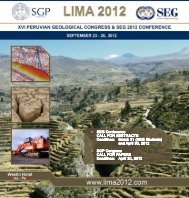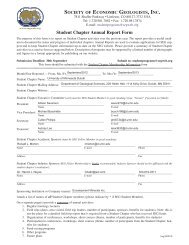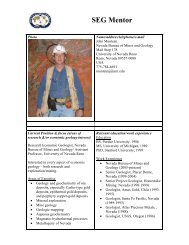Field Trip Report - Society of Economic Geologists
Field Trip Report - Society of Economic Geologists
Field Trip Report - Society of Economic Geologists
Create successful ePaper yourself
Turn your PDF publications into a flip-book with our unique Google optimized e-Paper software.
Sweden field trip report: <br />
SEG Student Chapter ETH Zürich <br />
17 th -‐26 th <strong>of</strong> June 2013 <br />
Stockholm, Sweden was the starting point for the trip around central and northern <br />
Sweden joined by 8 members <strong>of</strong> the SEG Student Chapter Zürich. <br />
Stops on the first day included outcrops and dumps <strong>of</strong> the historic Bästnas and Norberg <br />
mining districts known for REE and Fe-‐mineralisation in skarns. <br />
On the second day NewBoliden hosted a visit to their Garpenberg “VMS” Zn-‐Pb-‐Ag <br />
deposit. Johann Olsson and Michaela Aberg took us on tour along a drift, which showed <br />
different kinds <strong>of</strong> mineralization including later Ag-‐veinlets crosscutting earlier Zn-‐ and <br />
Pb-‐mineralization in skarns. During the afternoon Åsa Erlfeldt and Giovanni Cibrario <br />
were hosting a small discussion round on the larger scale deposits geology. Afterwards <br />
they took us to the core-‐shed to show us the different metavolcanic and <br />
metasedimentary sequences and different mineralization types in core. <br />
On June 18 th we stopped at outcrops and dumps <strong>of</strong> the Garpenberg area to see the <br />
surface exposure <strong>of</strong> some skarn mineralization and volcanic sequences. In the late <br />
morning we reached the Stollbergsgruva, a historic mine for Ag and Fe. In the afternoon <br />
we made stops to visit the dumps <strong>of</strong> the Grängesberg Fe-‐oxide-‐Apatite deposit and old <br />
workings <strong>of</strong> the Kopparberg/Finngruvan Cu workings. <br />
After staying the night at Lake Alvlangen we visited BIF-‐horizons on the lakeshore and <br />
Accreted Lapilli in the surrounding area. Then we went on our way to the Persberg and <br />
Langban mineral districts, which are famous for their mineral diversity and historic <br />
mining for Fe-‐skarns. Persberg is furthermore known as the birthplace <strong>of</strong> the term <br />
skarn. <br />
On June 21 st , we went to the Unesco cultural world heritage site at Falun. This historic <br />
mine has been mined for Copper since the 10 th century. The rest <strong>of</strong> the day we used to <br />
reach our destination <strong>of</strong> the day, lake Orsa. <br />
On June 22 nd , we went on a long drive to the north. The destination was the Svartliden <br />
deposit. The employees <strong>of</strong> Dragon mining invited us to their midsummer festivities in <br />
the evening. On the following day Katerina Schloglova introduced us to the Svartliden <br />
Au-‐mine on the Gold-‐line. She gave us a detailed overview <strong>of</strong> the different lithologies the <br />
structural control <strong>of</strong> the deposit and gave us a tour around the open pit. After the visit <br />
we set <strong>of</strong> towards Galliväre with a stop at a pegmatite near Jokkmokk with huge feldspar <br />
and biotite crystals. <br />
On June 24 th , Gregory Joslin and S<strong>of</strong>ia Höglund took us around the NewBoliden Aitik Au-‐<br />
Cu. The day started with an introduction into the deposit characteristics and mining <br />
methods. In the pit they introduced us to the metavolcanic and metasedimentary host <br />
lithologies that were subject to Amphibolite facies metamorphism. Furthermore, they
took us to outcrops <strong>of</strong> later pegmatite veins. The disseminated chalcopyrite and <br />
chalcopyrite-‐stringer mineralization was also pointed out. Afterwards we were taken <br />
around the processing plant at Aitik with their autogenous mill and flotation plants. <br />
After our visit we drove to our most northern stop <strong>of</strong> the trip at Kiruna. On June 25 th <br />
Kari Niiranen gave us a tour around the largest underground Fe-‐mine in the world <br />
operated by LKAB. The day started with a presentation about the deposit its different <br />
stratigraphies and mining methods. The underground visit gave an insight into <br />
machinery used in large-‐scale underground mines and the following tour <strong>of</strong> on <strong>of</strong> the <br />
processing plants explained some <strong>of</strong> the difficulties and advantages <strong>of</strong> mining for <br />
Kiruna-‐type Magnetite-‐Apatite ore. The day was rounded <strong>of</strong> with a visit to the core shed <br />
where most significant stratigraphies could be investigated. <br />
On the long drive back to Stockholm from Kiruna we made one final stop at outcrops <strong>of</strong> <br />
the Alnö Carbonatite on the coast <strong>of</strong> the Baltic Sea, one <strong>of</strong> the prime examples for <br />
Carbonatites in Europe. <br />
We would like to thank everyone who has helped us with organizing this field trip. All <br />
mentioned geologists in the visited mines and the associated companies as well as <br />
several geologists familiar with the geology <strong>of</strong> Sweden who gave us precious tips on <br />
which deposits and outcrops to visit and access to older field guides and further <br />
literature (e.g. Erik Jonsson, Hannes Mattsson, Benni Mattsson and Torbjörn Bergmann). <br />
Furthermore, we are grateful for the substantial funding from Data Metallogenica and <br />
the SEG!
Sulfide mineralization in skarn with later veinlets rich in Ag at the Garpenberg mine
Metre-‐scale biotite and feldspar crystals at a pegmatite near Jokkmokk
The Aitik Au-‐Cu open-‐pit mine
Participants <strong>of</strong> the field trip on the arctic circle



